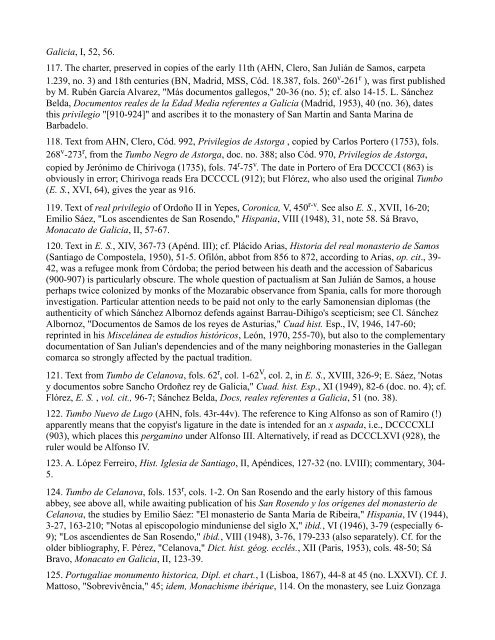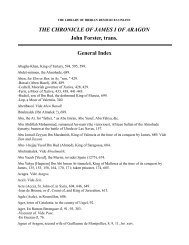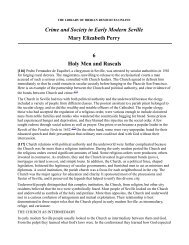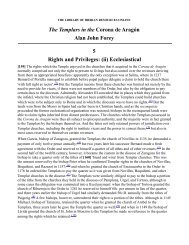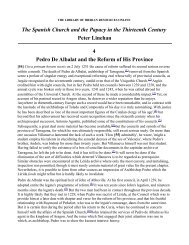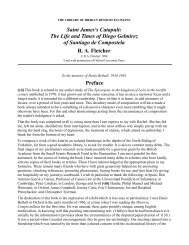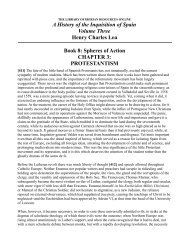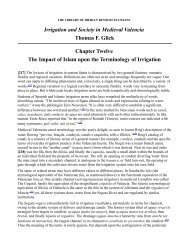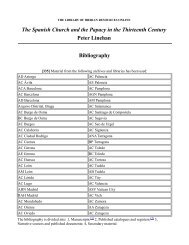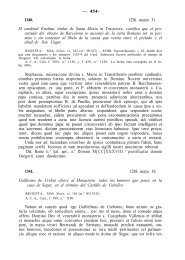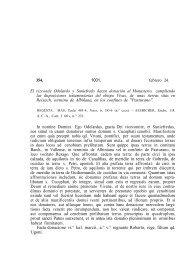The Pactual Tradition in Hispanic Monasticism - The Library of ...
The Pactual Tradition in Hispanic Monasticism - The Library of ...
The Pactual Tradition in Hispanic Monasticism - The Library of ...
Create successful ePaper yourself
Turn your PDF publications into a flip-book with our unique Google optimized e-Paper software.
Galicia, I, 52, 56.<br />
117. <strong>The</strong> charter, preserved <strong>in</strong> copies <strong>of</strong> the early 11th (AHN, Clero, San Julián de Samos, carpeta<br />
1.239, no. 3) and 18th centuries (BN, Madrid, MSS, Cód. 18.387, fols. 260 v -261 r ), was first published<br />
by M. Rubén García Alvarez, "Más documentos gallegos," 20-36 (no. 5); cf. also 14-15. L. Sánchez<br />
Belda, Documentos reales de la Edad Media referentes a Galicia (Madrid, 1953), 40 (no. 36), dates<br />
this privilegio "[910-924]" and ascribes it to the monastery <strong>of</strong> San Martín and Santa Mar<strong>in</strong>a de<br />
Barbadelo.<br />
118. Text from AHN, Clero, Cód. 992, Privilegios de Astorga , copied by Carlos Portero (1753), fols.<br />
268 v -273 r , from the Tumbo Negro de Astorga, doc. no. 388; also Cód. 970, Privilegios de Astorga,<br />
copied by Jerónimo de Chirivoga (1735), fols. 74 r -75 v . <strong>The</strong> date <strong>in</strong> Portero <strong>of</strong> Era DCCCCI (863) is<br />
obviously <strong>in</strong> error; Chirivoga reads Era DCCCCL (912); but Flórez, who also used the orig<strong>in</strong>al Tumbo<br />
(E. S., XVI, 64), gives the year as 916.<br />
119. Text <strong>of</strong> real privilegio <strong>of</strong> Ordoño II <strong>in</strong> Yepes, Coronica, V, 450 r-v . See also E. S., XVII, 16-20;<br />
Emilio Sáez, "Los ascendientes de San Rosendo," Hispania, VIII (1948), 31, note 58. Sá Bravo,<br />
Monacato de Galicia, II, 57-67.<br />
120. Text <strong>in</strong> E. S., XIV, 367-73 (Apénd. III); cf. Plácido Arias, Historia del real monasterio de Samos<br />
(Santiago de Compostela, 1950), 51-5. Ofilón, abbot from 856 to 872, accord<strong>in</strong>g to Arias, op. cit., 39-<br />
42, was a refugee monk from Córdoba; the period between his death and the accession <strong>of</strong> Sabaricus<br />
(900-907) is particularly obscure. <strong>The</strong> whole question <strong>of</strong> pactualism at San Julián de Samos, a house<br />
perhaps twice colonized by monks <strong>of</strong> the Mozarabic observance from Spania, calls for more thorough<br />
<strong>in</strong>vestigation. Particular attention needs to be paid not only to the early Samonensian diplomas (the<br />
authenticity <strong>of</strong> which Sánchez Albornoz defends aga<strong>in</strong>st Barrau-Dihigo's scepticism; see Cl. Sánchez<br />
Albornoz, "Documentos de Samos de los reyes de Asturias," Cuad hist. Esp., IV, 1946, 147-60;<br />
repr<strong>in</strong>ted <strong>in</strong> his Miscelánea de estudios históricos, León, 1970, 255-70), but also to the complementary<br />
documentation <strong>of</strong> San Julian's dependencies and <strong>of</strong> the many neighbor<strong>in</strong>g monasteries <strong>in</strong> the Gallegan<br />
comarca so strongly affected by the pactual tradition.<br />
121. Text from Tumbo de Celanova, fols. 62 r , col. 1-62 V , col. 2, <strong>in</strong> E. S., XVIII, 326-9; E. Sáez, 'Notas<br />
y documentos sobre Sancho Ordoñez rey de Galicia," Cuad. hist. Esp., XI (1949), 82-6 (doc. no. 4); cf.<br />
Flórez, E. S. , vol. cit., 96-7; Sánchez Belda, Docs, reales referentes a Galicia, 51 (no. 38).<br />
122. Tumbo Nuevo de Lugo (AHN, fols. 43r-44v). <strong>The</strong> reference to K<strong>in</strong>g Alfonso as son <strong>of</strong> Ramiro (!)<br />
apparently means that the copyist's ligature <strong>in</strong> the date is <strong>in</strong>tended for an x aspada, i.e., DCCCCXLI<br />
(903), which places this pergam<strong>in</strong>o under Alfonso III. Alternatively, if read as DCCCLXVI (928), the<br />
ruler would be Alfonso IV.<br />
123. A. López Ferreiro, Hist. Iglesia de Santiago, II, Apéndices, 127-32 (no. LVIII); commentary, 304-<br />
5.<br />
124. Tumbo de Celanova, fols. 153 r , cols. 1-2. On San Rosendo and the early history <strong>of</strong> this famous<br />
abbey, see above all, while await<strong>in</strong>g publication <strong>of</strong> his San Rosendo y los orígenes del monasterio de<br />
Celanova, the studies by Emilio Sáez: "El monasterio de Santa María de Ribeira," Hispania, IV (1944),<br />
3-27, 163-210; "Notas al episcopologio m<strong>in</strong>duniense del siglo X," ibid., VI (1946), 3-79 (especially 6-<br />
9); "Los ascendientes de San Rosendo," ibid., VIII (1948), 3-76, 179-233 (also separately). Cf. for the<br />
older bibliography, F. Pérez, "Celanova," Dict. hist. géog. ecclés., XII (Paris, 1953), cols. 48-50; Sá<br />
Bravo, Monacato en Galicia, II, 123-39.<br />
125. Portugaliae monumento historica, Dipl. et chart., I (Lisboa, 1867), 44-8 at 45 (no. LXXVI). Cf. J.<br />
Mattoso, "Sobrevivência," 45; idem, Monachisme ibérique, 114. On the monastery, see Luiz Gonzaga


